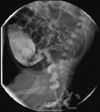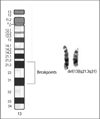Abstract
Chromosome 13q deletion syndrome, which is relatively rare, is characterized by a wide spectrum of phenotypes resulting from a partial deletion of the long arm of the chromosome 13. The main clinical features are mental retardation, developmental delay, craniofacial dysmorphism, and various congenital defects. Here, we report a de novo interstitial deletion in chromosome 13 (q21.3q31) in a neonate with congenital megacolon (Hirschsprung disease) confirmed by biopsy. A short tandem repeat analysis (D13S317) was used to compare the loci on the chromosomes of the patient and the parents, the latter representing the normal karyotype, to determine how the features of the profile peaks relate to the deletion. The clinical data were also compared with those of similar cases in previously published reports.
Figures and Tables
 | Fig. 2Partial karyotype of the patient at the 550-band level revealing 13q deletion: 46,XY, del(13)(q21.3q31). |
 | Fig. 4Short-tandem repeat profiles of the patient (A) and the parents: the father (B) and the mother (C). At the peak of D13S317, the patient shows a single 11-repeat allele, the mother shows 2 peaks for 11- and 12-repeat alleles, and the father shows a single 11-repeat allele. The height of the peaks was 162 for the patient, 139 (11-repeat) and 108 (12-repeat) for the mother, and 299 for the father. If the patient is homozygous for 11-repeat alleles, the peak should normally appear higher. Therefore, we interpreted that the patient had a deletion of chromosome 13. |
References
1. Lee CO, Lee TH, Lee DW, Lee SJ. One case of 13q-syndrome. J Korean Pediatr Soc. 1982. 25:743–747.
2. Chung JY, Lee JS, Kim BE, Choi MJ, Park DC, Kim SW, et al. A case of nonsyndromic intrahepatic bile duct paucity with congenital bilateral vocal cord paralysis and 13q deletion. Korean J Pediatr Gastroenterol Nutr. 2001. 4:108–112.

3. Chung JL, Choi JR, Park MS, Choi SH. A case of del(13)(q22) with multiple major congenital anomalies, imperforate anus and penoscrotal transposition. Yonsei Med J. 2001. 42:558–562.

4. Lee JR, Kim BJ, Kim DH, Jee BC, Park JS, Jun JK, et al. A case of terminal deletion of chromosome 13q. Korean J Obstet Gynecol. 2001. 44:1931–1936.
5. Hwang SJ, Lee JH, Park IY, Moon HB, Oh JW, Lee GSR, et al. A case of de novo ring (13) chromosome with deletion 13q33.2→qter. Korean J Obstet Gynecol. 2002. 45:323–326.
6. Ko YS, Kim MS, Choi SI, Cho SC. A case of 13q-syndrome with arthrogryposis multiflex congenita. J Korean Soc Neonatol. 2003. 10:103–107.
7. Lee SY, Jung HJ, Nam IH, Jang MY. A case of del 13(q24) syndrome with multiple anomalies. Korean J Pediatr. 2004. 47:1128–1131.
8. Ballarati L, Rossi E, Bonati MT, Gimelli S, Maraschio P, Finelli P, et al. 13q deletion and central nervous system anomalies: Further insights from karyotype-phenotype analyses of 14 patients. J Med Genet. 2007. 44:e60.

9. Kirchhoff M, Bisgaard AM, Stoeva R, Dimitrov B, Gillessen-Kaesbach G, Fryns JP, et al. Phenotype and 244k array-CGH characterization of chromosome 13q deletions: An update of the phenotypic map of 13q21.1-qter. AM J Med Genet A. 2009. 149A:894–905.

10. Quélin C, Bendavid C, Dubourg C, Rochebrochard C, Lucas J, Henry C, et al. Twelve new patients with 13q deletion syndrome: Genotype-phenotype analyses in progress. Eur J Med Genet. 2009. 52:41–46.

11. Tosca L, Brisset S, Petit FM, Metay C, Latour S, Lautier B, et al. Genotype-phenotype correlation in 13q13.3-q21.3 deletion. Eur J Med Genet. 2011. 54:e489–e494.

12. Allderdice PW, Davis JG, Miller OJ, Klinger HP, Warburton D, Miller DA, et al. The 13q-deletion syndrome. Am J Hum Genet. 1969. 21:499–512.
13. Brown S, Gersen S, Anyane-Yeboa K, Warburton D. Preliminary definition of a "Critical Region" of chromosome 13 in q32: Report of 14 cases with 13q deletions and review of the literature. Am J Med Genet. 1993. 45:52–59.

14. Brown S, Russo J, Chitayat D, Warburton D. The 13q-syndrome: The molecular definition of the critical deletion region in band 13q32. Am J Hum Genet. 1995. 57:859–866.
15. Kutzbach B, Mendelsohn N, Rath P, Summers CG. Sectoral iris heterochromia and retinal pigment variation in 13q-syndrome. J AAPOS. 2007. 11:513–515.

16. Tüysüz B, Collin A, Arapoğlu M, Suyugül N. Clinical variability of Waardenburg-Shah syndrome in patients with proximal 13q deletion syndrome including the Endothelin-B receptor locus. Am J Med Genet A. 2009. 149A:2290–2295.

17. Gariepy CE. Genetic basis of Hirschsprung disease: implications in clinical practice. Mol Genet Metab. 2003. 80:66–73.

18. Amiel J, Sproat-Emison E, Garcia-Barcelo M, Lantieri F, Burzynski G, Borrego S, et al. Hirschsprung disease, associated syndromes and genetics: a review. J Med Genet. 2008. 45:1–14.

19. Broască V, Ciobotaru C, Dimofte I, Aşchie M, Prună A, Severin B. The correlation of genetic markers with anatomoclinical and histopathological forms in Hirschsprung's disease. Rom J Morphol Embryol. 2010. 51:283–288.




 PDF
PDF ePub
ePub Citation
Citation Print
Print





 XML Download
XML Download